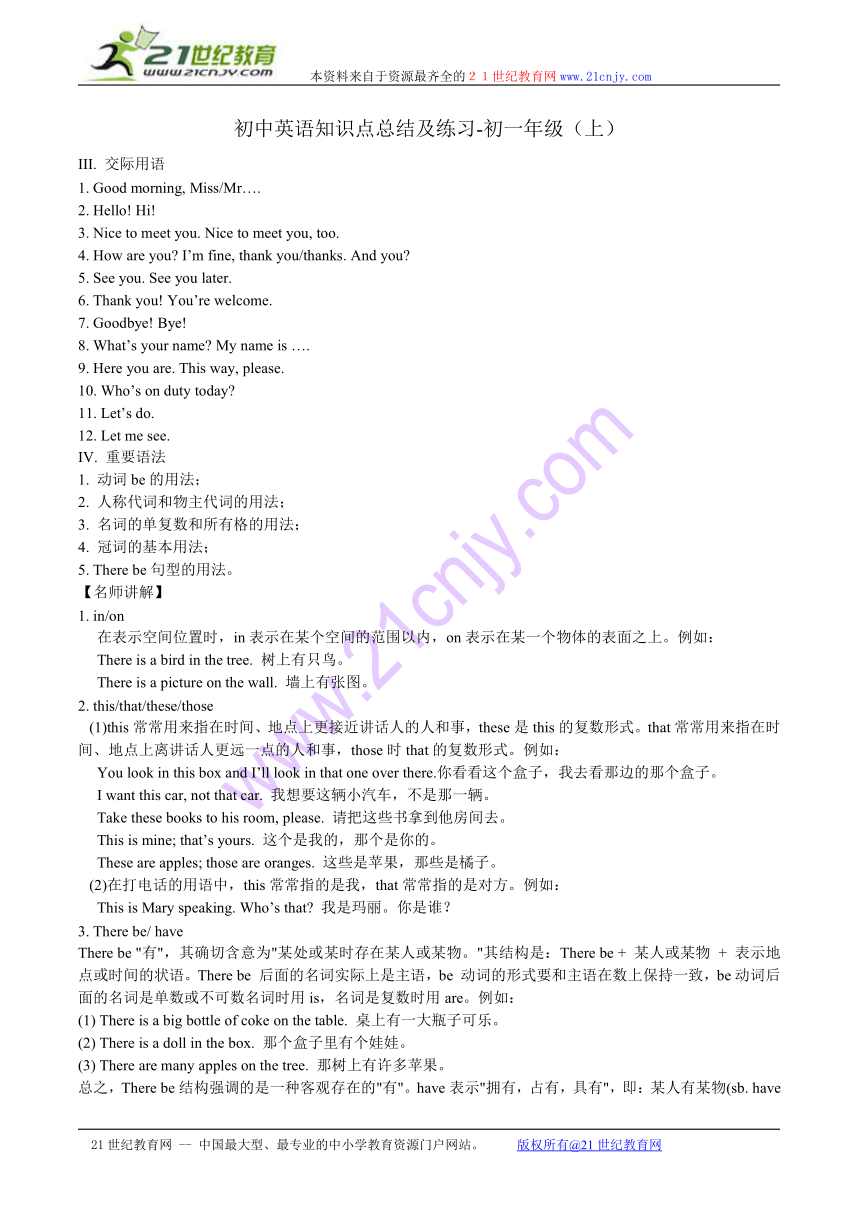
初中英语知识点总结及练习-初一年级(上) III. 交际用语�1. Good morning, Miss/Mr….�2. Hello! Hi!�3. Nice to meet you. Nice to meet you, too.�4. How are you? I’m fine, thank you/thanks. And you? 5. See you. See you later.�6. Thank you! You’re welcome.�7. Goodbye! Bye!�8. What’s your name? My name is ….�9. Here you are. This way, please.�10. Who’s on duty today?�11. Let’s do.�12. Let me see.�IV. 重要语法�1. 动词be的用法;�2. 人称代词和物主代词的用法;�3. 名词的单复数和所有格的用法;�4. 冠词的基本用法;�5. There be句型的用法。�【名师讲解】�1. in/on�??? 在表示空间位置时,in表示在某个空间的范围以内,on表示在某一个物体的表面之上。例如:�??? There is a bird in the tree. 树上有只鸟。�??? There is a picture on the wall. 墙上有张图。 2. this/that/these/those�? (1)this常常用来指在时间、地点上更接近讲话人的人和事,these是this的复数形式。that常常用来指在时间、地点上离讲话人更远一点的人和事,those时that的复数形式。例如:�??? You look in this box and I’ll look in that one over there.你看看这个盒子,我去看那边的那个盒子。�??? I want this car, not that car. 我想要这辆小汽车,不是那一辆。�??? Take these books to his room, please. 请把这些书拿到他房间去。�??? This is mine; that’s yours. 这个是我的,那个是你的。�??? These are apples; those are oranges. 这些是苹果,那些是橘子。�? (2)在打电话的用语中,this常常指的是我,that常常指的是对方。例如:�??? This is Mary speaking. Who’s that? 我是玛丽。你是谁?�3. There be/ have�There be "有",其确切含意为"某处或某时存在某人或某物。"其结构是:There be + 某人或某物 + 表示地点或时间的状语。There be 后面的名词实际上是主语,be 动词的形式要和主语在数上保持一致,be动词后面的名词是单数或不可数名词时用is,名词是复数时用are。例如:�(1) There is a big bottle of coke on the table. 桌上有一大瓶子可乐。�(2) There is a doll in the box. 那个盒子里有个娃娃。�(3) There are many apples on the tree. 那树上有许多苹果。 总之,There be结构强调的是一种客观存在的"有"。have表示"拥有,占有,具有",即:某人有某物(sb. have / has sth.)。主语一般是名词或代词,与主语是所属关系。例如:�(4) I have two brothers and one sister.我有两个兄弟,一个姐姐。�(5) That house has four rooms.那所房子有四个房间。�4. look/ see/ watch (1)look 表示“看、瞧”,着重指认真看,强调看的动作,表示有意识地注意看,但不一定看到,以提醒对方注意。,如:�Look! The children are playing computer games. 瞧!孩子们在玩电脑游戏。�Look! What’s that over there? 看!那边那个是什么?�单独使用是不及物动词,如强调看某人/物,其后接介词at,才能带宾语,如:�He’s looking at me。他正在看着我。�(2)see强调“看”的结果,着重的是look这个动作的结果,意思是“看到”,see是及物动词,后面能直接跟宾语。如:�What can you see in the picture? 你能在图上看到什么?�Look at the blackboard. What did you see on it? 看黑板!你看到了什么?�(3)watch“观看,注视”,侧重于场面,表示全神贯注地观看、观察或注视某事务的活动,强调过程,常用于“看电视、看足球、看演出”等。如:�Yesterday we watched a football match on TV.昨天我们从电视上看了一场足球比赛。 4. put on/ / in put on意为“穿上,戴上”。主要指“穿上”这一动作, 后面接表示服装、鞋帽的名词。�in 是介词,表示“穿着 ... ...
~~ 您好,已阅读到文档的结尾了 ~~